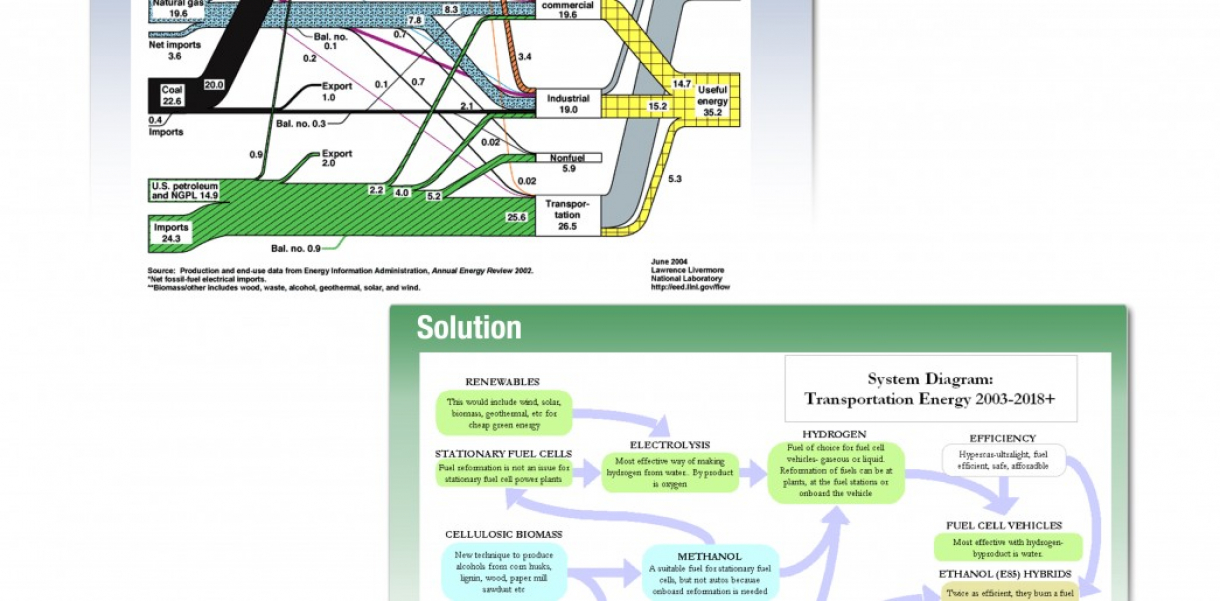A STRATEGY: MOVING AMERICA AWAY FROM OIL, INDEX: AWARD 2005 FINALIST.
Functionality and use of design
A three-phase strategy is needed to revamp and renew the U.S. transportation sector:
1. Vast improvements in efficiency; mainly through hybrid vehicles and new lightweight designs.
2. Investment in a large-scale initiative to produce bio-fuels; mainly through cellulosic biomass.
3. Use bio-fuels as feedstock for fuel cells in the long-term.
How did this design improve life?
The design describes how America can move towards ethanol and be free of fossil fuel dependence in the transportation sector within a 15 year timeframe. Moving towards ethanol, and renewable and cleaner fuel, will allow America to be ready for a transition to hydrogen fuel cell cars without a change in the fuel distribution infrastructure.
There are 10 general major benefits to this strategy: 1. It uses existing infrastructure to move the U.S. away from oil in the most expedient fashion. 2. It moves the U.S. to energy independence – fast. 3. It uses the shorter-term solution – alternative biofuels with existing infrastructure – as a stepping-stone to the longer fuel cell and hydrogen solution. 4. It uses renewable fuels. 5. It is politically viable because of a strong agricultural lobby. 6. It creates jobs in rural areas. 7. It upends the U.S. trade deficit. (The U.S. currently spends $70 billion for imported oil, which is 40% of the current trade deficit.) 8. It uses the newest technologies. 9. It will contribute no net carbon dioxide to the atmosphere. 10. It is flexible enough to allow for new technologies and discoveries to arise in the next decade that will alter or accelerate this transition.
Drawbacks of life improvement
It is of significant importance for the United States to rapidly move toward energy independence in the very near future. Our lack of energy independence makes our economy and way of life vulnerable to global instabilities through potentially disrupted supply and distribution chains. Also, our lack of energy independence often forces us to support and do business with countries that, in President Bush’s words, “are not our friends.” Thus, via unfriendly regimes, the money we spend on foreign oil too often goes to fund the same terrorists with whom we find ourselves in conflict. As such, this strategy posits the most expedient way for the U.S. to move away from oil, and even more quickly, away from imported oil.
However, in this era of globalization, it is apparent more now than ever how interdependent each person, community, and country is, in economic, political, and other terms as well. Through advances in communication, technology, and transportation, the world has become too small and interconnected for any country to think they can take care of themselves with ambivalence toward the rest of the world. Thus, an isolationist stance regarding energy policy is strictly untenable.
By creating a strategy that makes oil less useful, on one hand we posit a solution to a very important problem, but the consequences around the world, and especially in the Middle East, cannot be ignored. Middle East problems would certainly multiply if oil rapidly lost its value as would similar issues in a number of other countries that are exclusively dependent upon oil exports to prop up their governments.
There are some who suggest that, if the transition were at a slow enough pace, a Middle East, Nigeria and Venezuela free of oil wealth would actually create opportunities for true economic development to occur. These pundits suggest that history shows that countries rich in oil create and sustain large gaps between the rich and the poor. They say the oil acts as a hindrance to the country – keeping the elites content enough to maintain enough stability without opportunities, money, and education trickling down to the masses. If the demand for oil gradually decreased over a period of several decades, the foreign oil producers could anticipate the change and begin investing in other potential resources and industries, such as minerals, food, and pharmaceuticals, thus averting a long-term crisis.
The other side of the argument is that if oil were to suddenly lose its value, the oil producing countries could become very instable with anarchy breaking out in the most oil dependent countries. Potentially, there could be a redistribution of power as old regimes fall, and new regimes are created. A scenario not too dissimilar from this is included in John Petersen’s, “Out of the Blue; Wild Cards and Other Big Future Surprises” where all fossil fuels become obsolete.
The implications of this possibility are vast. Will chaos break out? Will old regimes fall, countries collapse, and new borders drawn? Will the change present an opportunity for democracy to take hold in countries never seen before?
The answers are not too clear. But the questions are very important, and serious scenario development in this area would be a requisite of any complete strategy. These questions should be addressed in the very near future, as this reality of a world without oil appears to be not too far around the corner.
Research and need, the process
While the impetus for the report is geopolitical, the focus is technological. However, social, political, economic and environmental vectors are considered.
- Commissioned by the Office of the Secretary of Defense/Net Assessment, the project is designed to:
- Consider the history of the dominance of major fuels and understand why and how the world transitioned to each new era
- Establish the present state of global fossil fuel reserves, projected usage, and availability horizons
- Determine the present state of development of both conventional and unconventional alternative fuel sources
- Develop scenarios of possible early transitions from oil dependency
- Explore the political and economic implications for the U.S. in each scenario
- Develop a strategy for transition out of the oil age and identify the policy initiatives that would be required to enable it
The project’s structure is composed of a research segment, a workshop, and a final report.
The Research
Extensive research was undertaken to identify the history of fuel dominance in the developed world, the present state of global fossil fuel reserves, usage, and future availability, and to assess the development of conventional and unconventional alternative sources. Our objective was to establish a credible understanding of historical precedents in the energy area and begin to look into the future and identify plausible alternatives to the status quo. (Summaries of this research can be found in the Appendix on the report).
The Workshop, January 7-8, 2003, The Arlington Institute
As part of this project, The Arlington Institute held a two-day alternative energy workshop in January. Eleven experts in energy, national security, and politics convened at The Arlington Institute offices. The workshop was designed around the utilization of Think Tools™ technology, which provides an unequaled, robust methodology for developing scenarios and strategies. The workshop was structured to: - Consider a broad spectrum of trends and surprise events that could significantly influence future energy scenarios - Build a variety of scenarios of possible transitions away from oil dependence - Identify the most effective options to be included in the strategy and how they might interact - Identify the most effective strategies for achieving the most desirable scenarios - Indicate the policy initiatives that would be required to execute the strategies - Build a risk analysis of the most effective strategic option
The Report
This final report presents the complete strategy, details on the underlying logic, resources that are required, alternatives that were considered, the risks associated with the initiative, and a scenario that might also contribute to an effective energy transition.
Designed by
John L.Petersen, Humera Khan & Dane Ericksen (United States), 2003






